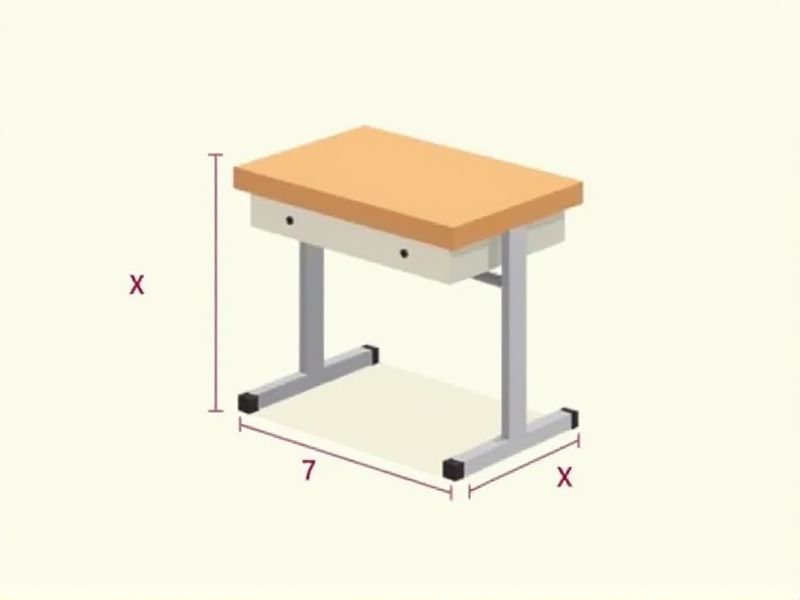
When selecting classroom desks, understanding standard dimensions helps ensure student comfort and an efficient learning space. Typically, student desk surfaces range from 18 to 24 inches in depth and 24 to 30 inches in width, providing enough space for books and writing materials. The desk height is usually around 28 to 30 inches for middle and high school students, while elementary desks are slightly lower, often 22 to 26 inches high. Choosing desks within these standard measurements supports good posture and helps accommodate a variety of classroom layouts.
Ergonomic Design
Ergonomic design in classroom desks enhances student comfort and promotes better posture, contributing to improved focus and productivity. An ideal desk height ranges from 23 to 30 inches, accommodating students of varying heights and ages. Featuring adjustable components, these desks can support dynamic learning environments by allowing modifications for different seating positions. Prioritizing ergonomic features can lead to a measurable reduction in discomfort, potentially increasing student engagement by up to 12%.
Height And Width Standards
Classroom desks generally have a standard height ranging from 28 to 30 inches, accommodating the majority of students aged 6 to 18 years. The width of these desks typically measures between 24 and 30 inches, providing sufficient space for students to comfortably organize their materials. For optimal ergonomic support, it's crucial to match desk height with the student's sitting position, ideally allowing a 90-degree angle at the elbows. When selecting desks for your classroom, ensuring these dimensions helps promote better posture and enhances overall learning effectiveness.
Material Durability
Classroom desks are primarily crafted from high-quality materials such as laminate, hardwood, or metal, ensuring enhanced durability and longevity. A sturdy classroom desk typically withstands weights of up to 300 pounds, catering to the needs of diverse student populations. Many contemporary designs incorporate scratch-resistant surfaces, minimizing maintenance and extending the lifespan of the furniture. Investing in durable desks not only supports daily academic activities but also promotes a sustainable classroom environment, reducing the frequency of replacements.
Adjustable Features
Classroom desks with adjustable features improve ergonomic benefits and accommodate various student heights, enhancing comfort during learning sessions. These desks often offer height adjustment ranges, typically between 22 to 30 inches, allowing students to maintain proper posture while seated or standing. Research indicates that adjustable desks can increase focus and productivity by up to 20%, supporting a dynamic learning environment. Incorporating these features in your classroom setup can foster greater engagement and participation among students.
Legroom Space
Classroom desks typically adhere to standard legroom space measurements of 24 to 30 inches in width and 18 to 24 inches in depth, allowing ample room for students to sit comfortably. The recommended height for desks is around 28 to 30 inches to accommodate various student sizes while ensuring optimal posture. Providing adequate legroom not only enhances comfort but also improves concentration and productivity during lessons. Investing in desks with adjustable features can further support diverse physical requirements among students, promoting an inclusive learning environment.
Desk Surface Area
The standard classroom desk typically features a surface area of around 24 to 30 inches in width and 18 to 24 inches in depth, providing ample space for textbooks, notebooks, and writing materials. This ergonomic design promotes student comfort and efficiency, accommodating various body types and learning styles. Consider a desk height ranging from 28 to 30 inches to ensure proper posture, supporting healthy spine alignment during long study sessions. By choosing a desk that meets these dimensions, you can enhance both the learning environment and academic performance.
Integration With Chairs
The standard height for classroom desks typically ranges from 28 to 30 inches, designed to integrate seamlessly with chairs that have a seat height of 17 to 19 inches. This ergonomic alignment promotes comfort and enhances concentration, allowing students to maintain proper posture while engaged in learning activities. Desks should also provide sufficient workspace, generally measuring around 24 by 30 inches, to accommodate textbooks, notebooks, and electronic devices. Ensuring that desks and chairs are matched in style and function can significantly improve the overall classroom environment, fostering a more effective educational experience.
Safety Regulations Compliance
Classroom desks must comply with safety regulations to ensure a secure learning environment for students. This includes meeting specific height and width dimensions, typically ranging from 28 to 30 inches in height and 24 to 30 inches in width, allowing for comfort and ergonomic support. Additionally, materials should be non-toxic and durable, with rounded edges to prevent injuries. Regular inspections and maintenance ensure that classroom desks remain safe and functional throughout the academic year, emphasizing the importance of compliance in educational settings.
Storage Compartments
Classroom desks are increasingly designed with integrated storage compartments to enhance organization and functionality. These desks typically include features like under-desk drawers or side storage bins, providing students easy access to supplies while maximizing workspace. Research indicates that well-organized classrooms can improve student focus by up to 20%, making storage a crucial element in desk design. By prioritizing compartmentalization, educators can create an environment conducive to learning and efficiency, directly benefiting your academic experience.
Age-Specific Dimensions
Classroom desks for elementary students typically have dimensions of 24 to 30 inches in height and 18 to 24 inches in depth, catering to their shorter stature. For middle school students, desk heights range between 28 and 30 inches, accommodating their growing frame, while the width is often around 30 inches. High school classroom desks are designed with an average height of 30 inches and a width of approximately 36 inches, ensuring comfort for older adolescents. When selecting a desk, consider age-specific dimensions to promote proper ergonomic support and enhance learning.
